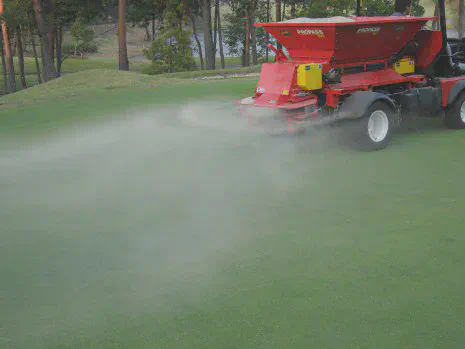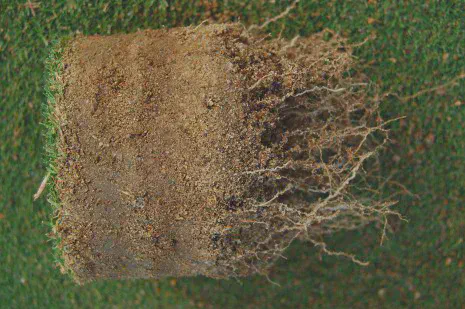N & MLSN: what's the connection?
We’ll get to the N below. But wow! I didn’t know silica was such a hot topic!
After writing a few days ago (original post here) about silica and green speed, and how it doesn’t make sense to me that silica application could increase green speed, there was quite a response — by e-mail, at this wild discussion on Facebook, and on Twitter.
Korai (Zoysia matrella) greens are notorious for the high silica content of their leaves, but they are not noted for being exceptionally fast. Except when they are dormant. The idea that leaves with more turgor pressure, or leaves with more silica, could somehow be faster, still doesn’t make sense. If that were the case, actively growing korai greens would be faster than dormant korai.

Fortunately, data on green speed are easy to obtain, so if silica application really does increase green speed, someone should be able to measure it.

Jason Hooper sees the benefit not as something to increase green speed, but from silica application for plant defense against pests:
@asianturfgrass Applying silica for green speed is ridiculous. Applying it to boost plant defense against pests and stress is why we do it.
— Jason Hooper (@superjhooper) February 28, 2015
Continuing that discussion, I pointed out (with the help of John Dempsey) that silica application (in this case, calcium silicate) can also cause a dramatic increase in turf disease, especially with brown patch. So although I think Si application to turf is something worth investigating, and because the reported results are so divergent, Si is something that especially calls for a check plot.
Jason pointed out that MLSN might not be all good either, and that with low levels of N, if that is what the MLSN guidelines were recommending, there could be increased disease too, particularly dollar spot and anthracnose:
@asianturfgrass the one concern about MLSN for me is the potential for $ spot or anthracnose with low levels of N.
— Jason Hooper (@superjhooper) March 1, 2015
I want to explain that now, because grass with low N in the leaves is more prone to dollar spot or anthracnose when the other conditions are right for those diseases.
But the MLSN guidelines don’t include N. MLSN guidelines are for the macronutrients K and P and for the secondary nutrients Ca, Mg, and S. There is no MLSN guideline for N, and none for the micronutrients.1
There are two parts to my explanation.
First, the MLSN guidelines don’t include a recommendation for N. When I talk about N, I explain it like this. Adding more N makes the grass grow faster, and reducing N supply results in grass that grows slower. One of the (maybe the most important) most important tasks for the turfgrass manager is to control the growth rate of the grass. The optimum growth rate is to grow just enough to recover from traffic damage. The optimum growth rate is very site specific.
Turfgrass managers will generally choose the nitrogen application rate based on three things. They will look at the color of the grass and decide whether they want it to be the same, greener, or less green in the future. They will check the growth rate of the grass, and also consider whether that current growth rate should be adjusted. And they will consider the way N has been applied in the past, what the results of those applications were, and incorporate that knowledge, and an assessment of the current turf conditions and weather and weather forecast, to consider if the amount and source of N applied in the past should be applied again, or if it should be adjusted.
This is not part of MLSN, but I suggest it can be added to those three things. The temperature-based growth potential of PACE Turf can be an excellent site-specific predictor of how much N the grass may use at different times of the year. That information can be added to the color, growth rate, and experience to help choose the optimum N application rate. To try it out, the climate appraisal form from PACE Turf has all the equations embedded. You can input temperature, grass type, and maximum N rates for your site to see how this works.
To reiterate, N recommendations are not part of MLSN. The turfgrass manager decides what growth rate is desired at the facility, and chooses the N rate by whatever method desired.
Second, and this is where N supply and MLSN fertilizer recommendations are connected, when I calculate a K, P, Ca, Mg, or S recommendation based on soil test results and the MLSN guidelines, I will consider how much N is applied at that location. This is part of the a + b - c approach that I explained in this presentation. How do I integrate N?
a is the amount of an element the grass uses. That is where N comes in. b is the MLSN guideline, nothing to do with N. c is the Mehlich 3 soil test result for an element, nothing to do with N.
To estimate a, I recognize that when more N is applied, the grass is going to grow more. As it grows more, the quantity of nutrients harvested from the soil are more. Thus, the fertilizer recommendation for an element increases the more N is applied.
One of the fundamental questions I ask about any turfgrass management practice is why are we doing this? I’m glad Jason is questioning MLSN. Question everything! In this case, however, I don’t see that there is any connection between MLSN, N, and increased potential for disease.